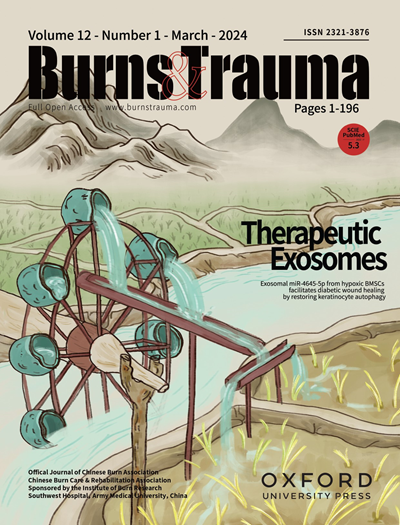S-亚硝基化介导的DJ-1与PTEN偶联诱导PI3K/AKT/mTOR通路依赖性瘢痕疙瘩的形成
IF 6.3
1区 医学
Q1 DERMATOLOGY
引用次数: 0
摘要
背景瘢痕疙瘩是一种异常的真皮伤口愈合,其特点是侵入性生长、细胞外基质沉积、细胞因子过度表达和容易复发。许多因素被认为是瘢痕疙瘩的病理原因,尤其是过度活跃的炎症、张力排列和遗传易感性。S-亚硝基化(SNO)是蛋白质修饰的一种独特形式,与局部炎症反应有关,但其在过度纤维化和瘢痕疙瘩形成中的功能仍不清楚。我们旨在发现蛋白质 SNO 与瘢痕疙瘩形成之间的关联。方法 从采集的正常皮肤和瘢痕疙瘩组织中分离出正常和瘢痕疙瘩成纤维细胞。获得的成纤维细胞在添加了 10%胎牛血清和 1% 青霉素/链霉素的 DMEM 中培养。检测了 DJ-1 对细胞增殖、凋亡、迁移和侵袭以及蛋白质表达的影响。通过基于 TurboID 的接近标记和液相色谱-质谱联用技术来探索 DJ-1 的潜在靶标。生物素开关测定和反硝化反应用于检测蛋白质 SNO。定量数据通过双尾学生 t 检验进行比较。结果 我们发现,DJ-1 是促进瘢痕疙瘩细胞增殖、迁移和侵袭的重要正调控因子。在瘢痕疙瘩中观察到较高的S-亚硝基化DJ-1(SNO-DJ-1)水平,DJ-1对瘢痕疙瘩的作用依赖于DJ-1蛋白Cys106残基的SNO。研究发现,在瘢痕疙瘩中,SNO-DJ-1可通过反硝基化作用增加磷酸酶和天丝蛋白同源物(PTEN)在其Cys136残基上的S-亚硝基化水平,从而降低PTEN的磷酸酶活性并激活PI3K/AKT/mTOR通路。此外,Cys106突变的DJ-1对SNO具有耐受性,并能减弱DJ-1-PTEN耦合和PTEN蛋白的SNO,从而抑制PI3K/AKT/mTOR通路并缓解瘢痕疙瘩的形成。重要的是,DJ-1在瘢痕疙瘩中的生物效应依赖于SNO-DJ-1/SNO-PTEN/PI3K/AKT/mTOR轴。结论 本研究首次证明了 DJ-1 至 PTEN 的反硝基化作用通过 PI3K/AKT/mTOR 信号通路促进瘢痕疙瘩的形成,这表明 DJ-1 的 SNO 可能是治疗瘢痕疙瘩的新型治疗靶点。本文章由计算机程序翻译,如有差异,请以英文原文为准。
S-Nitrosylation-mediated coupling of DJ-1 with PTEN induces PI3K/AKT/mTOR pathway-dependent keloid formation
Background Keloids are aberrant dermal wound healing characterized by invasive growth, extracellular matrix deposition, cytokine overexpression and easy recurrence. Many factors have been implicated as pathological causes of keloids, particularly hyperactive inflammation, tension alignment and genetic predisposition. S-Nitrosylation (SNO), a unique form of protein modification, is associated with the local inflammatory response but its function in excessive fibrosis and keloid formation remains unknown. We aimed to discover the association between protein SNO and keloid formation. Methods Normal and keloid fibroblasts were isolated from collected normal skin and keloid tissues. The obtained fibroblasts were cultured in DMEM supplemented with 10% fetal bovine serum and 1% penicillin/streptomycin. The effects of DJ-1 on cell proliferation, apoptosis, migration and invasion, and on the expression of proteins were assayed. TurboID-based proximity labelling and liquid chromatography-mass spectrometry were conducted to explore the potential targets of DJ-1. Biotin-switch assays and transnitrosylation reactions were used to detect protein SNO. Quantitative data were compared by two-tailed Student’s t test. Results We found that DJ-1 served as an essential positive modulator to facilitate keloid cell proliferation, migration and invasion. A higher S-nitrosylated DJ-1 (SNO-DJ-1) level was observed in keloids, and the effect of DJ-1 on keloids was dependent on SNO of the Cys106 residue of the DJ-1 protein. SNO-DJ-1 was found to increase the level of phosphatase and tensin homolog (PTEN) S-nitrosylated at its Cys136 residue via transnitrosylation in keloids, thus diminishing the phosphatase activity of PTEN and activating the PI3K/AKT/mTOR pathway. Furthermore, Cys106-mutant DJ-1 is refractory to SNO and abrogates DJ-1-PTEN coupling and the SNO of the PTEN protein, thus repressing the PI3K/AKT/mTOR pathway and alleviating keloid formation. Importantly, the biological effect of DJ-1 in keloids is dependent on the SNO-DJ-1/SNO-PTEN/PI3K/AKT/mTOR axis. Conclusions For the first time, this study demonstrated the effect of transnitrosylation from DJ-1 to PTEN on promoting keloid formation via the PI3K/AKT/mTOR signaling pathway, suggesting that SNO of DJ-1 may be a novel therapeutic target for keloid treatment.
求助全文
通过发布文献求助,成功后即可免费获取论文全文。
去求助
来源期刊

Burns & Trauma
医学-皮肤病学
CiteScore
8.40
自引率
9.40%
发文量
186
审稿时长
6 weeks
期刊介绍:
The first open access journal in the field of burns and trauma injury in the Asia-Pacific region, Burns & Trauma publishes the latest developments in basic, clinical and translational research in the field. With a special focus on prevention, clinical treatment and basic research, the journal welcomes submissions in various aspects of biomaterials, tissue engineering, stem cells, critical care, immunobiology, skin transplantation, and the prevention and regeneration of burns and trauma injuries. With an expert Editorial Board and a team of dedicated scientific editors, the journal enjoys a large readership and is supported by Southwest Hospital, which covers authors'' article processing charges.
 求助内容:
求助内容: 应助结果提醒方式:
应助结果提醒方式:


